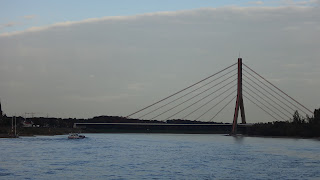Cologne is mainly known for the Cathedral, but there's a lot to see and do while visiting this city that has close to 1 million residents. We arrived at Cologne on probably the worse day - day after Halloween. So most shops were closed for All Saints Day.
Let's get started at the Alstadt houses. These houses are considered some of the original buildings and therefore protected. They lean into each other as to almost hold each other up from the weathering of time.
Around the corner are several narrow streets. Mainly lined with bars, restaurants and shops for tourists to enjoy. The night before was Halloween, so the streets were absolutely deserted when we arrived the next morning.
 Over each of the bars, they still have the signs/artwork depicting what's sold inside.
Over each of the bars, they still have the signs/artwork depicting what's sold inside.
 One souvenir that most people get is eau de Cologne (4711 Haus). Inside the shop is also a museum. It's easy to find as it's across from the Cathedral.
One souvenir that most people get is eau de Cologne (4711 Haus). Inside the shop is also a museum. It's easy to find as it's across from the Cathedral.
Another fun thing to do is sampling the freshly drawn Kolsch beer. Which also describes the small glasses they are served in .2 liter glasses. These small glasses make it fun to sample a variety of beers.
Next stop is the Cathedral - Dom from 13th century. It's literally too big to get in one shot. I therefore took several to give you an idea of the enormous size of the Cathedral.
 |
| Beautiful medieval stain glass windows |
 |
| This is 1 of the actual tops of the spires. It gives you just another reminder of the size of this church. |
 |
| Inside of the church looking at the Chancel |
The Cologne Cathedral is Germany's most visited building and is a UNESCO World Heritage Site. Miraculously it was almost unscathed by the blanket bombing of the city during the 2nd World War. It took centuries to complete the building of this amazing church.
Once we arrived to Cologne everything was in walking distance and along the river. Next stop is Amsterdam. Before we arrive/dock there, we will float by Dusseldorf.
Happy Traveling!








































